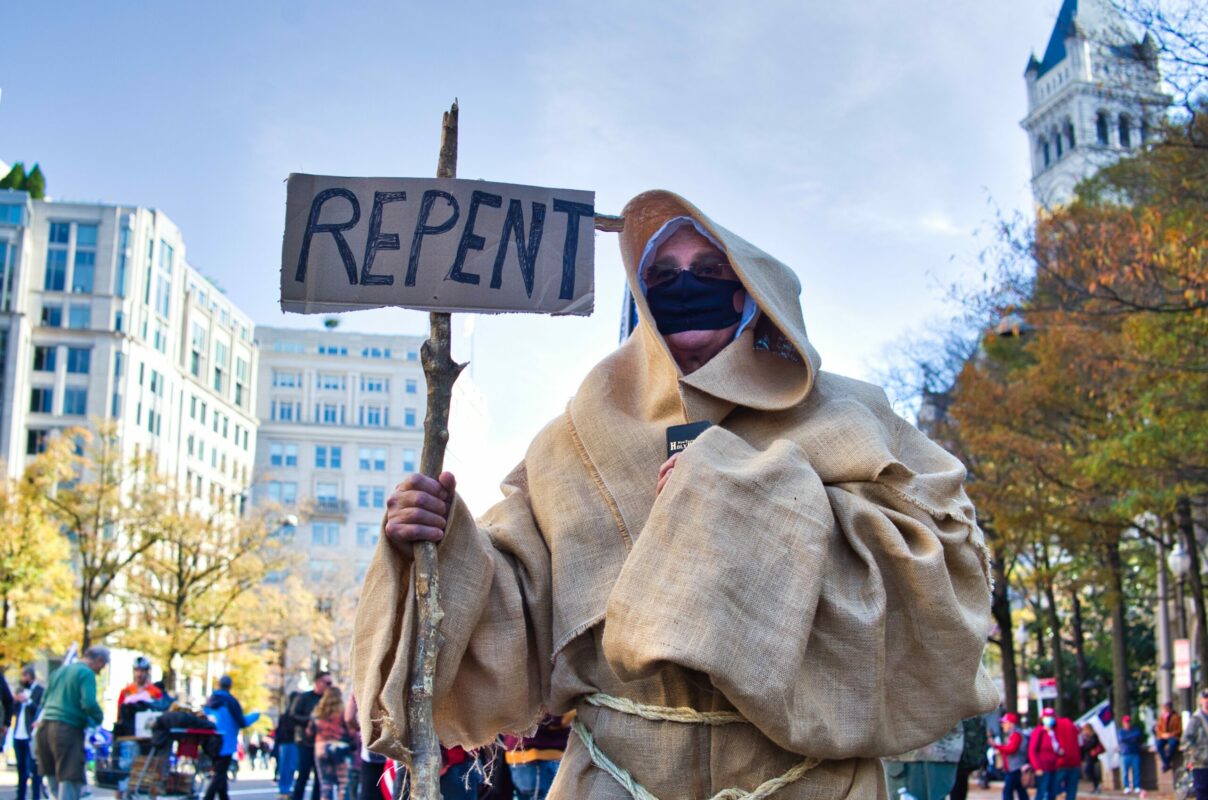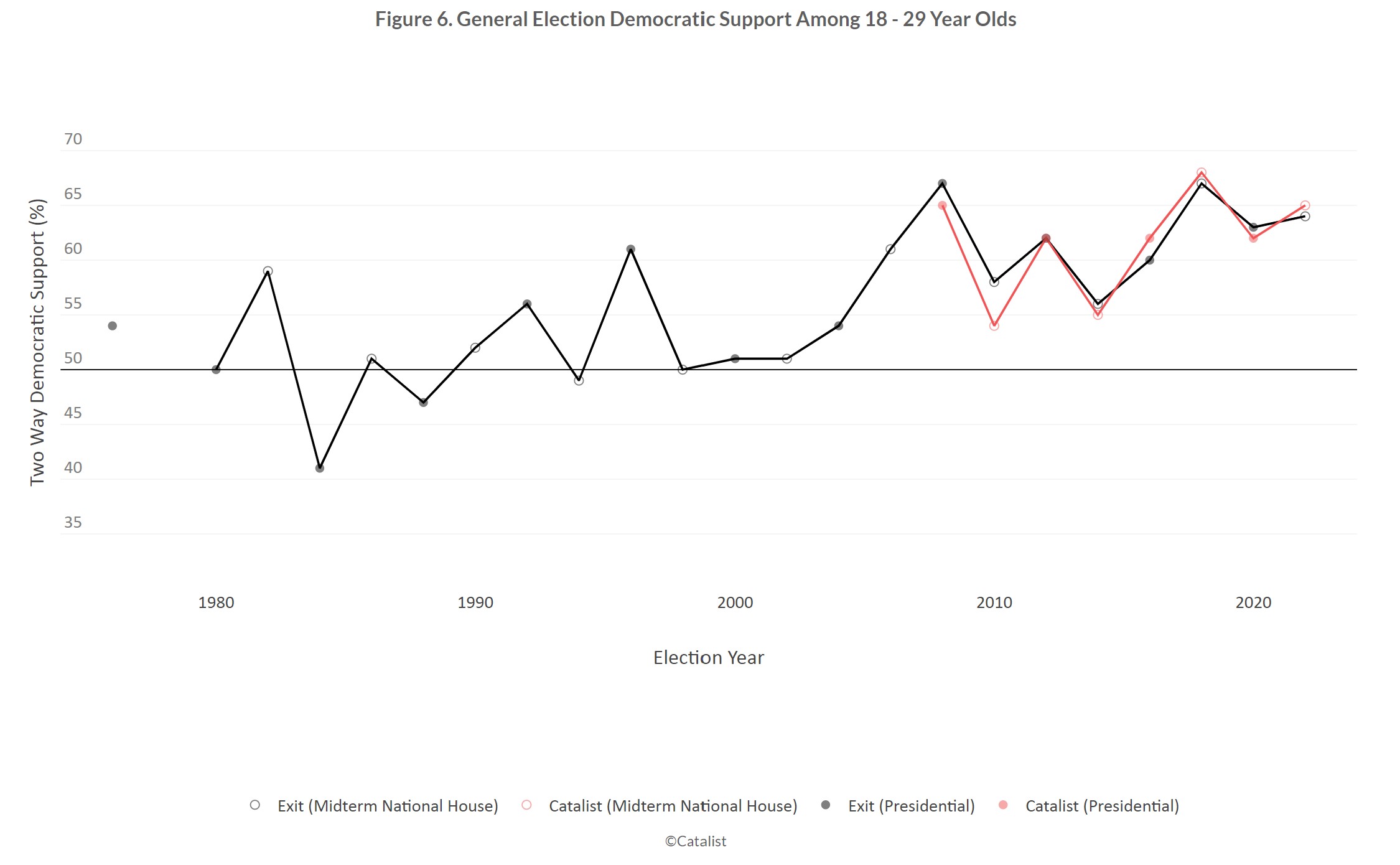One year ago, the Republican-dominated Supreme Court rolled back 50 years of settled precedent with its decision in Dobbs v. Jackson Women’s Health Organization. But the decision didn’t just upend abortion access, it also appears to have accelerated some demographic trends which had already been breaking toward Democrats by letting voters know what the Republican Party actually wants.
Decades before political scientists began speaking about “negative partisanship,” the far-right activists who took over the party in the 1960s discovered that it was much easier to mobilize people by talking less about their own policy agenda and much more about cultural controversy. As Richard Viguerie, the inventor of political direct mail put it decades later: “Fear and anger are much stronger motivations than support for a cause.”
To the extent that national Republicans talked about the laws they wanted to pass, they restricted their rhetoric to cutting taxes and increasing funding for the military and police. By the 2020 Republican National Convention, they didn’t even bother with the pretense of a public agenda, not even releasing a party platform.
While the Republicans in DC have been loathe to publicly campaign on their policies, state-level Republicans have been increasingly radical at enacting theirs, slashing education budgets, censoring public libraries and teachers, and even working to lower the minimum wage.
In our nationalized political environment, however, none of these extreme actions managed to attract much public attention. The Dobbs decision changed all that. By repealing the 50-year-old Roe v. Wade decisions, the Supreme Court’s Republican justices thrust the party’s reactionary activists into the national spotlight as they have passed laws designed to criminalize miscarriages, prosecute people for helping someone travel to another state for abortion, force child rape victims to give birth, ban abortions before many people even know they’re pregnant, and speak openly about their desire to make both abortion and birth control pills illegal.
The public seems to be paying attention, finally realizing that the Republican party is interested in more than just tax cuts and deregulation. The depth of this opposition has made abortion a potent political issue, and it is likely to remain at the forefront of the political landscape heading into the 2024 elections.
Beginning with Kansas in August of last year, voters have resoundingly rejected anti-abortion ballot measures, and support for legal abortion as measured by opinion polls remains high, reaching its peak since the 1990s. Gallup found that 52 percent identified as “pro-choice” in May, the highest percentage recorded since 1996. According to a recent Pew Research Center poll, 62 percent of Americans believe abortion should be legal in all or most cases, matching the results of a survey conducted immediately after the Dobbs decision.
Proposals to ban or restrict prescription drugs to terminate pregnancies face even greater opposition. A May Kaiser Family Foundation poll revealed that 72 percent of Americans believe abortion pills like mifepristone should be legal in all or most cases. Only 27 percent of respondents said they should be mostly or entirely illegal.
Abortion access also appears to have emerged as a pivotal issue to motivate Democratic voters. As has been widely documented, it was a significant factor in several highly contested 2022 midterm elections, but it continues to be a driving force.
Gallup’s polling indicates a significant shift in motivation among voters who identify as “pro-choice” and “pro-life.” For the first time since 1996, more voters told Gallup that they were “pro-choice” than “pro-life.” Closely related to this is that these self-identified pro-choice voters say they are more enthusiastic about supporting candidates with similar views. According to the survey, 33 percent expressed a willingness to support candidates who align with their position, compared to 23 percent of “pro-life” voters.
The Dobbs decision and the floodlight it put on Republican religious radicalism seems to have also increased support among young voters for Democrats, according to a 2022 electoral analysis conducted by the left-leaning data organization Catalist.
Contrary to the cliché that young people are always reliably leftist, between the late 1970s and the early 2000s, young voters’ support for the Democratic Party generally varied from 50 percent to 60 percent of the two-party vote, occasionally even dipping below 50 percent, according to exit polls.
More recently, however, things appear to be shifting. The 2006 midterm elections saw a surge in support as opposition to the Iraq War resonated with young voters. This trend continued in 2008 during President Obama’s first election. In contrast, the midterm years of 2010 and 2014 witnessed a significant decline in support among young voters. This can be attributed to a combination of young Democrats abstaining from those elections and a general decrease in support for Democrats during a Republican wave year.
Since 2016, young Democratic support has remained remarkably robust, with the past two midterm elections displaying strong support. In 2018, support peaked at 68 percent, and it has continued to remain high in 2022. More ominously for Republicans, 2022 marks the first time that young people’s Democratic support has exceeded 60 percent for two consecutive midterm elections, including one with a Democratic incumbent president.
Some of the leftward tilt of Generation Z compared to its predecessors is related to the group’s more diverse racial composition, but as Catalist’s analysis shows, 58 percent of 18-29 young White voters supported Democrats last year, an increase of 5 points from 2018.
The real problem for Republicans, as pollster John Della Volpe has noted, is that the White Christian identity politics that the party has used in the past to compensate for its always unpopular policies does not work on today’s younger people, precisely because they are significantly less likely to be White or Christian. As the Republican Party has become more empowered to enact its values by the right-wing Supreme Court, it is awakening large-scale anger from Generation Z adults who have had to directly bear the brunt of GOP policies on health care, gun availability, and gender discrimination.
Following stunning defeats of anti-abortion ballot measures and candidates in a variety of Republican-leaning states, some GOP leaders have begun trying to dial things back. After Kansas voters made themselves clear last year, Sen. Lindsey Graham (R-SC) tried to rally the party around a 15-week abortion ban in the hopes of staving off earlier-week bans favored by reactionary Christian activists. His measure did not even receive a vote.
Disgraced ex-president Donald Trump has also provoked outrage from anti-abortion groups by blaming them for the party’s failures last year.
“It was the ‘abortion issue,’ poorly handled by many Republicans, especially those that firmly insisted on No Exceptions, even in the case of Rape, Incest, or Life of the Mother, that lost large numbers of Voters,” he wrote in a January social media post.
More recently, Trump has refused to take a position on when he would prohibit abortions, while continuing to say that he supports exceptions to bans on the procedure.
“Some people are at six weeks, some people are at three weeks, two weeks,” he said during a May CNN town hall broadcast. “President Trump is going to make a determination what he thinks is great for the country.”
How the Republican Party resolves its internal divisions on abortion is yet to be determined. Trump’s rival Florida Gov. Ron DeSantis is trying to inflame the party’s hard-right activist corps on the issue by campaigning on the 6-week ban he recently signed. The personal loyalty Trump commands may prevent DeSantis’s effort from working, but it is also the case that Trump routinely allowed Christian right activists to set his White House policy agenda.
Wherever national Republicans end up, there’s no question that the Supreme Court’s Dobbs decision has had a lasting impact on public opinion, reshaped candidate messages, and pulled millions to the voting booth. And as the ballot measure losses for abortion opponents have piled up, Republicans in a number of states are trying to change the rules to prevent further ones.
The disparity between the campaign advertisements of President Joe Biden and various Republican presidential candidates further underscores the significance of abortion in the 2024 election. According to the political ad tracker AdImpact, Biden’s ads have consistently mentioned abortion, reflecting its importance to his campaign. In contrast, none of the ads supporting Republican candidates have broached the topic in their television ads so far.
Defending abortion access isn’t likely to be the sole issue that will propel Democrats into office in 2024, but there is no doubt that abortion rights have become the easiest way for Americans to realize that today’s Republican party is anything but conservative.

